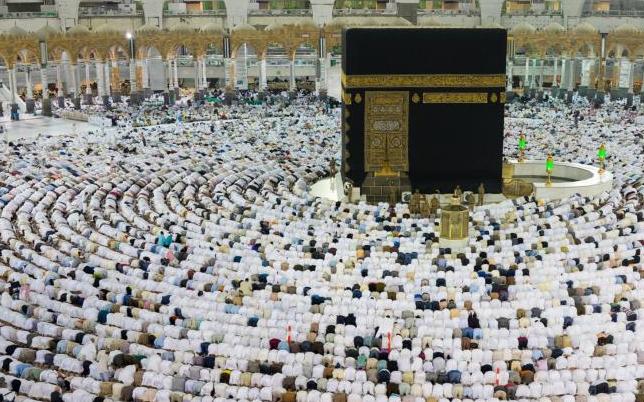There are two major festivals of Muslims: Eid al-Fitr and Eid al-Adha. Eid al-Fitr occurs immediately after the month of Ramadan, on the first day of the month of Shawwal which is the tenth month in the Islamic calendar while Eid al Adha falls on the 10th of Dhil Hijjah, the twelfth month in the Islamic calendar.
Eid al Adha
Eid al-Fitr occurs immediately after the month of Ramadan and since Ramadan is the month of fasting, renunciation and self-discipline, Muslims all over the world eagerly await sighting of the moon of Eid al Fitr. On the twenty-ninth day of Ramadan, Muslims of all ages and ranks eagerly try to sight the moon.
If the moon is not sighted on the twenty-ninth, Muslims fast the following day and try to sight the moon on the thirtieth. When the moon is sighted, Muslims happily greet and congratulate each other. Youngsters offer respectful greetings and salutations to elders. Children run to the elderly members of the family and women with the happy news of the sighting of the moon and are rewarded with good wishes and blessings.
Those who are educated in Islamic teachings and wish to follow the traditions of the Prophet Muhammad (blessings and peace be on him), recite the following prayer at the sight of the moon:

O Allah! let this month begin with us with peace and belief, security and obedience, and guidance to the deeds that please You. (O moon)! my Sustainer as well as Yours is Allah.
Preparations for Eid al-Fitr
Preparations for Eid al-Fitr begin quite a few days in advance. Especially at night before the Eid day there is so much liveliness and excitement at home as well as in the market.
Preparations for Eid begin quite early in the morning. To mark the ending of the month of fasting, Muslims take their breakfast in the morning and start preparing for the Eid prayer. They take a bath, wear new dress (if they could afford), apply perfume and proceed to the place where congregational prayer for Eid is be held.
Before Muslims go for prayer, they offer a charity in cash or grain to the poor, which is called Sadaqatul Fitr. This charity as a matter of fact is a gesture on the part of Muslims to express their thankfulness to the Lord for the blessings of fasting. It is offered to the poor by all financially well-off Muslim men and women for themselves as well as for their children including the infants.
To offer the Eid al-Fitr prayer after the sunrise was the practice of the Prophet Muhammad and earlier it is offered after the sunrise, the better it is.
Eid al-Fitr Prayer
When Muslims proceed for Eid al-Fitr prayer, they keep on proclaiming Allah’s praise and their thankfulness to Him in a low voice. Following the practice of the Prophet of Allah (blessings and peace be on him) they prefer to go for prayer by one way and return by another so that Allah’s glory may well be proclaimed and their attachment to religion as well as their unity may well be reflected.
For Eid prayer there is no Iqamah (final call marking the commencement of the; prayer), nor are any Sunnah or Nafl prayers said before it. When Muslims gather and the time fixed for prayers arrives, the Imam advances and leads the prayer. After completing the prayer, he mounts to the pulpit and delivers the Eid al-Fitr sermon. This sermon usually sheds light on the true spirit and message of Eid al-Fitr, religious laws concerning it, and needs and demands of the current time.
Eid al Adha
In Eid al-Adha an additional deed of sacrificing an animal in the name of Allah is performed. Sadaqatul Fitr (charity given in Eid al Fitr) is not offered in Eid al Adha. This festival falls on the 10th of Dhil Hijjah, the twelfth month in the Arabic calendar. On the day of Eid al Adha the pilgrims complete rituals of Hajj (Pilgrimage) and come to stay at a place called Mina, which is four miles from Makkah. The pilgrims then engage themselves as best as possible in remembering Allah, offering prayers, sacrificing animals, and enjoying with gratitude food and other gifts of Allah.
An important distinction between Eid al Fitr and Eid al Adha is that while Eid al Fitr is celebrated for one day, Eid al-Adha continues for three days. The Eid al-Adha prayer is offered on the 10th of Dhil Hijjah, but sacrifices can be offered up to the 12th. In Eid al Adha some special words marking Allah’s praise and glory are said loudly by worshippers after each obligatory prayer, beginning with Salatal Fajr (Morning Prayer) of the 9th of Dhil Hijjah and continuing up to the Salatal Asr (Afternoon Prayer) of the 13th of Dhil Hijjah. These are called Takbirate Tashreeq and its wordings are as follows:

Allah is the greatest, Allah is the greatest.
None is worthy of worship except Allah.
Allah is the greatest, Allah is the greatest.
And all praise is for Him.
Meat of the Sacrificed Animal on Eid al Adha
The meat of the sacrificed animal is divided into three parts: one part for the family, the other for friends, and the third for the poor and needy. The three days of Eid al-Adha are marked as happy days for eating and drinking and Muslims are instructed not to fast during days of Eid al Adha and Eid al Fitr. Usually Muslims eat good food in Eid al Adha; even poor persons get to eat good food such as meat in abundance on that day.
Global Dimensions of Eid al Fitr and Eid al Adha
Eid al-Fitr and Eid al-Adha are international festivals of Muslims which are celebrated by them all over the world irrespective of their national, social, or financial differences. That is why in all countries of the world, whether Muslims live there in majority or in minority, these festivals are celebrated more or less in the same manner. Such a uniformity is possible only because the rituals followed in these festivals are determined by the Quran and the Hadith and have been observed uniformly since the days of the Prophet Muhammad.

